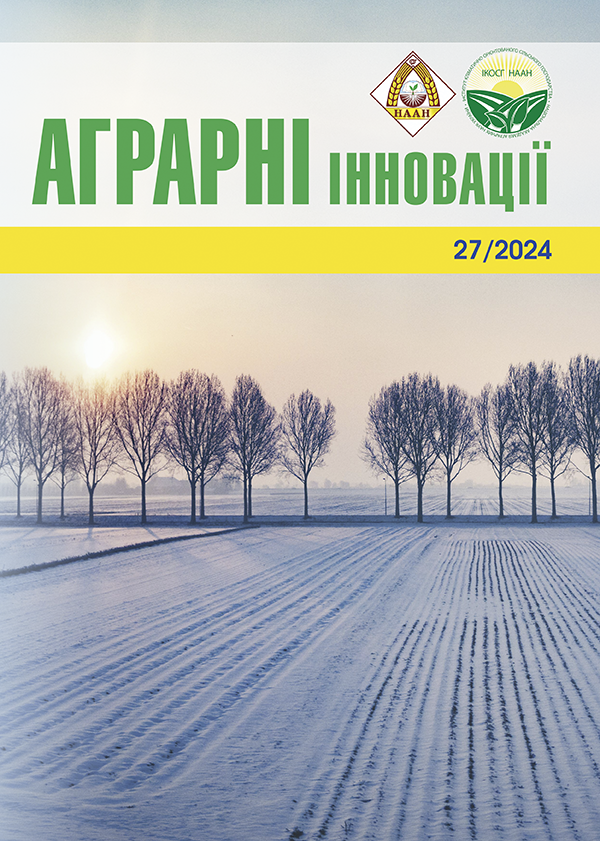THE EFFECT OF BIOLOGICAL PREPARATION AND ORGANO-MINERAL FERTILIZER ON THE MORPHOLOGICAL PARAMETERS OF VARIETIES OF MEDICINAL HYSSOP IN THE CONDITIONS OF SOUTHERN UKRAINE
Abstract
The study of the effect of biological preparation and organo-mineral fertilizer on the morphological indicators of varieties of medicinal hyssop in the South of Ukraine is an important component of agronomic practices, since this region is characterized by specific microclimatic conditions that can significantly affect the growth and development of plants. The purpose of the study is to increase the yield and quality of medicinal hyssop, as well as determine the optimal conditions for the growth and development of this crop. Methodology. The study of the effect of the biological preparation and organo-mineral fertilizer on the morphological indicators of the varieties was carried out by the method of phenological observations on 25 model plants for each variety in accordance with the Methodology for the examination of the varieties of decorative, medicinal and essential oil, forest plant varieties for suitability for distribution in Ukraine. The experiments were laid out on a general agrotechnical background with the same care for plants during the entire observation period. The research results indicate a significant synergistic effect of the combined use of the biological preparation and organo-mineral fertilizer Biochar Aktive + Groundfix® to improve the productivity of medicinal hyssop. In 2022-2024, the use of this combination contributed to an increase in the morphological indicators of plants by 15-40% compared to the control, while Groundfix® alone showed less effectiveness. In particular, the Marquis variety showed record productivity in 2023, forming 29 inflorescences. Conclusion. Under the conditions of integrated use of Biochar Aktive + Groundfix®, an average increase in plant height by 12%, an increase in the number of first-order branches by 17%, second-order by 31%, and an increase in the number of inflorescences by 32% compared to the control were recorded.
References
2. Фокін А. Біологічний захист лікарських культур. Пропозиція. URL: https://propozitsiya.com/ua/biologichniy-zahist-likarskih-kultur (дата звернення: 20.09.2024).
3. Коваленко О. А. Елементи живлення гісопу лікарського за краплинного зрошення на Півдні України. Аграрні інновації. 2022. No. 14. P. 51–59. DOI : https://doi.org/10.32848/agrar.innov.2022.14.8
4. Методика проведення експертизи сортів рослин групи декоративних, лікарських та ефіроолійних, лісових на придатність до поширення в Україні / за ред. С. О. Ткачик. Вінниця : ФОП Корзун Д. Ю., 2017. 129 с. URL: https://sops.gov.ua/uploads/page/5b7e660408703.pdf
5. Гнатюк Н. О. Розподіл біогенних елементів у ґрунті під час вирощування ароматичних рослин. Науковий вісник НЛТУ України. 2014. Вип. 24. С. 111–119.
6. Добровольський П. А. Параметри продуктивності гісопу лікарського за вирощування в умовах південного Степу України. Таврійський науковий вісник. 2021. № 120. С. 36–42. DOI: https://doi.org/10.32851/2226-0099.2021.120.5
7. Буряк А. О., Коломієць Ю. В. Особливості мікроклонального розмноження гісопу лікарського. Досягнення і перспективи в захисті та карантині рослин : матеріали ІІІ Всеукраїнська наук.-практ. конф. здобувачів вищої освіти, м. Київ, 23 квітня 2024 р. Київ : НУБіП України, 2023. С. 164–165.
8. Salachna P. Depolymerised Sodium Alginate as a Eco-Friendly Biostimulant for Improving Herb Yield and Nutrient Accumulation in Hyssop. Journal of Ecological Engineering. 2023. Vol. 24, no. 9. P. 105–111. DOI: https://doi.org/10.12911/22998993/168553
9. Some agronomic characteristics and essential oil composition of hyssop (Hyssopus officinalis L.) under cultivation conditions / Kizil S., Güler V., Kirici S., Turk M. Acta Sci. Pol. Hortorum Cultus. 2016. Vol. 15, № 6. P. 193–207. URL: https://czasopisma.up.lublin.pl/asphc/article/view/2524/1781
10. Judžentienė A. Hyssop (Hyssopus officinalis L.) Oils. Essential Oils in Food Preservation, Flavor and Safety. 2016. P. 471–479. URL: https://doi.org/10.1016/b978-0-12-416641-7.00053-5
11. Quantity and quality of hyssop (Hyssopus officinalis L.) affected by precision harvesting / Saebi A., Minaei S., Mahdavian A. R., Ebadi M.-T. International Journal of Horticultural Science and Technology. 2020. DOI: https://doi.org/10.22059/ijhst.2020.298266.346.






